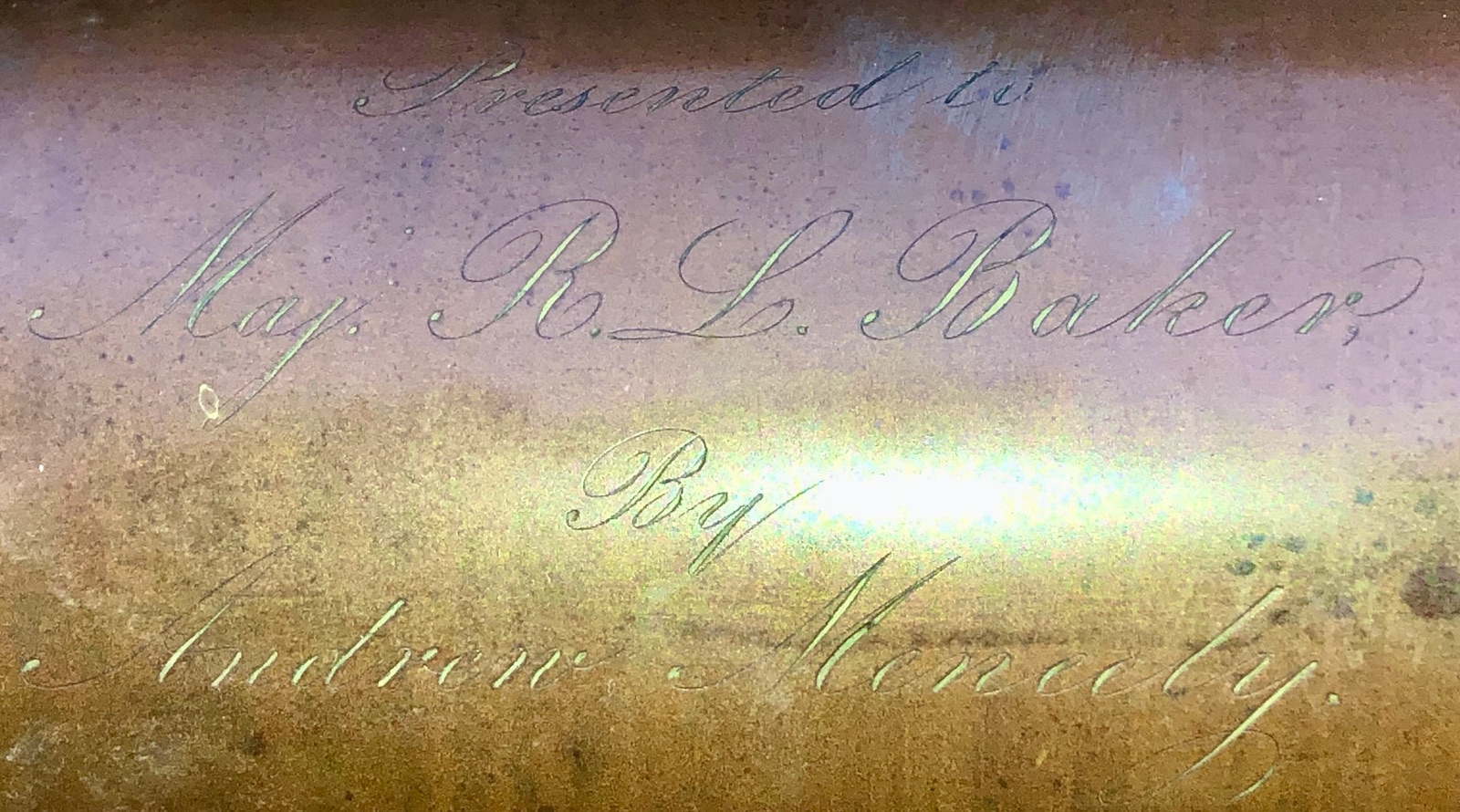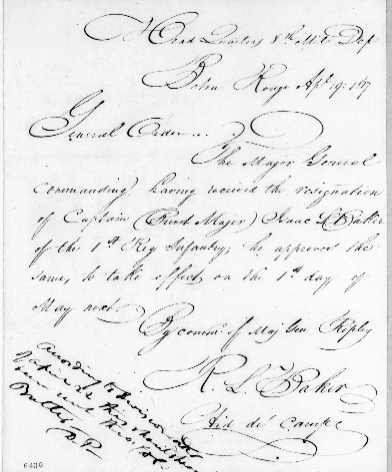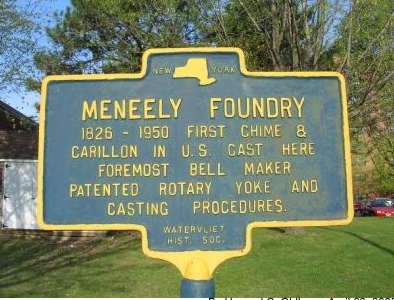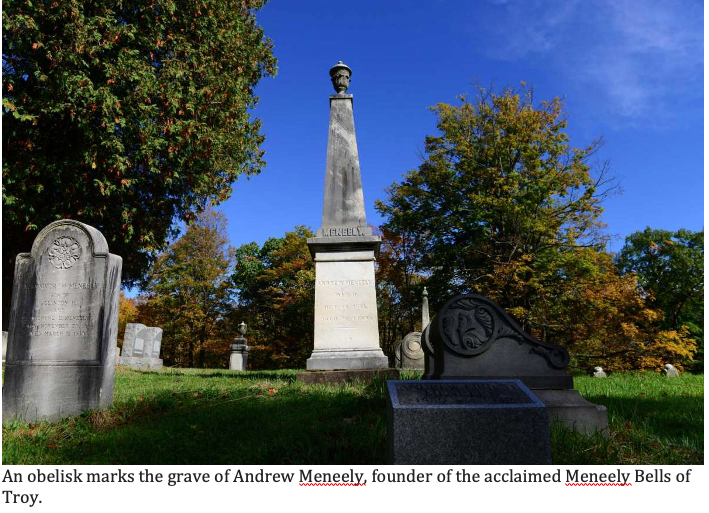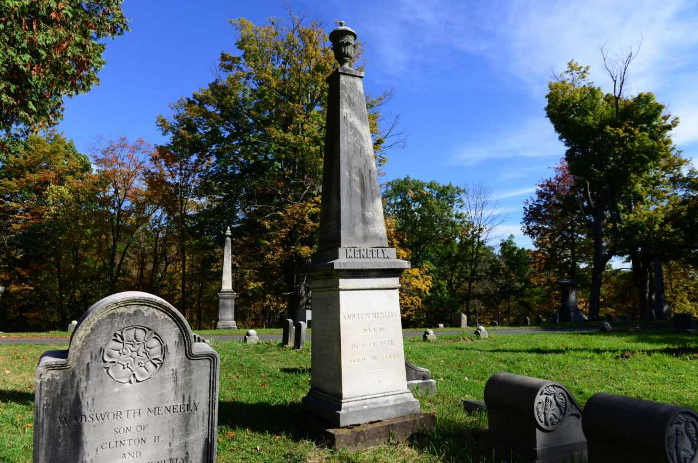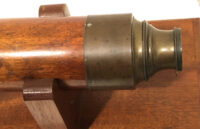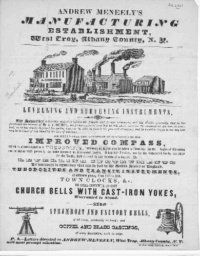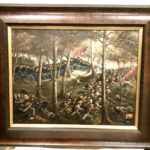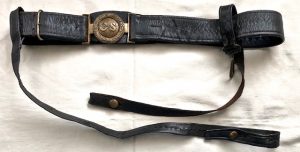Finely Crafted 19th Century Telescope Presented to Maj. Rufus L. Baker U.S. Army Major of Ordnance at Watervliet Arsenal
SOLD
Finely Crafted 19th Century Telescope Presented to Maj. Rufus L. Baker U.S. Army Major of Ordnance at Watervliet Arsenal – This fine telescope was presented in 1838, to Maj. Rufus Lathrop Baker, then at the rank of Major of the U.S. Army’s Ordnance department, by Andrew Meneely, one of the owners of the famed Meneely Bell Foundry of West Troy (now Watervliet), New York; this firm, started in 1826, cast bronze cannons, manufactured engineering equipment and bells; they also supplied equipment for the construction of the Erie Canal. The Meneely Bell Foundry became one of the most sought after purveyors of cast bells, catering to clients throughout the United States and Europe. We presume that Baker and Meneely interacted due to their mutual proximity to the Troy, NY area, as Baker was an Ordnance Captain at the Watervliet Arsenal during this period. Initially a Senior Captain of Ordnance upon his arrival at Watevliet, in 1838, and Baker was promoted, on July 7, 1838, to the rank of Major of Ordnance, at the arsenal. We presume that Andrew Meneely presented the telescope to Major Baker, in July of 1838, in recognition of his promotion. The telescope is engraved, as follows, on the lower, long, brass tube cover of the telescope:
“Presented to
Maj. R. L. Baker
By
Andrew Meneely”
The telescope is in excellent condition, retaining its beautiful, mahogany center tube sheath; the optics are good and both sliding dust covers, on the eyepiece and objective lenses, remain. There are some minor dings and bends to the lower brass ring of the objective lens. The telescope is a so-called “one pull” type, but is rather large, measuring 36.5” in length when fully pulled out and about 21.5” when the long, extended barrel is pushed into the larger main barrel. Major Baker, ultimately, Lt. Col. Baker, had a long career, both in the military and in business; he made an unsuccessful run for Congress, prior to the Civil War and later became the president of the Sharps Rifle Manufacturing Company, in 1856. During his military career, he established an arsenal in the Detroit area; was commandant at the Allegheny Arsenal; served as an arms inspector, for the U.S. Army – his cartouche initials were “RLB”; was sent to Europe, in 1840, by the Secretary of War, as a member of a military commission to review foundry and ordnance processes. Meneely would die at the relatively young age of 49, although his foundry would continue in business, managed by his sons.
Rufus Baker (1790-1868) was born to Joseph Baker and Lucy Devotion in Windham, Connecticut. He married Eliza Taintor, daughter of Charles Taintor, in June 1818. They had two children: Charles Taintor Baker, born in 1822 in Windham County, Connecticut; and William Rufus Baker, born in 1830 at Allegheny Arsenal, Pittsburg, Pennsylvania.
Baker served in the United States Army as first lieutenant assistant deputy commissary of ordnance in 1813, captain of ordnance in 1832, and lieutenant colonel in 1851. In 1818, Baker was ordered to Detroit to establish an arsenal, which he completed in 1819 at a site in Dearborn, Michigan. He resigned from office in 1854, and spent the remaining 14 years of his life largely devoted to the state Democratic Party, running unsuccessfully for Congress. Baker was elected President of Sharps Rifle Manufacturing Company in 1856, shortly after the company’s manufacturing operations moved from Windsor, Vermont, to Hartford, Connecticut.
When Colonel Rufus Lathrop Baker was born on 6 December 1790, in Brooklyn, Windham, Connecticut, United States, his father, Dr. Joseph Baker, was 41 and his mother, Lucy Devotion, was 36. He married Eliza Taintor on 2 June 1818, in Norwich, New London, Connecticut, United States. They were the parents of at least 2 sons. He lived in Windham, Windham, Connecticut, United States in 1860. He died on 5 June 1868, in Windham, Connecticut, United States, at the age of 77, and was buried in Windham, Windham, Connecticut, United States.
Ordnance Department
by Major C. E. Dutton, Ordnance Dept., U. S. A.
The Ordnance Department was organized as a distinct branch of our military establishment by an act of Congress approved May 14, 1812. The duty of providing military stores for the army and militia had devolved prior to that time upon a purveyor of public supplies acting under the direction of the Secretary of War. Everything except small arms was purchased, mainly by contract, and the Secretary personally supervised the contracts. The examination of accounts now performed in the staff bureau was made in the office of an accountant of the War Department. The duties of supplying ordnance material vested in the Secretary himself. When an addition of 6000 men was made to the army in 1808 these duties became excessive and burdensome to the Secretary, but no relief was granted until the war with Great Britain was impending, when bills were passed establishing a Quartermaster and an Ordnance Department. An act of May 14, 1812, provided for a Commissary General of Ordnance, an assistant commissary general, four deputy commissaries, and as many assistant deputy commissaries as the President might think necessary not exceeding eight.
An act approved February 5, 1815, “For the better regulation of the Ordnance Department,” provided a body of officers, consisting of one colonel, one lieutenant colonel, two majors, ten captains, and ten of each of first, second and third lieutenants. As this act, so far as relates to the Department itself, independently of its personnel, is regarded as its organic law, and, with only minor modifications by more recent acts, is still in force, it may be well to indicate briefly its most important features. It authorized the chief officer of the new department, “under the direction of the Secretary for the Department of War,” to enlist artisans and laborers; to direct the inspection and proof of all cannon and small arms; to direct the construction of gun carriages, equipment, implements, and ammunition; to make estimates and contracts for, and purchases of ordnance supplies and stores, and to issue them to the army; to exact from armories and arsenals quarterly returns of property and to receive from all responsible officers reports of damages to ordnance material; to establish ordnance depots; to prepare regulations for the government of the Ordnance Department and forms of returns and reports. The public armories and arsenals were placed under his direction, and the duty of arming and equipping the militia from the permanent appropriation of $200,000 per annum provided by the law of April 23, 1808, devolved upon the new department.
The colonel and chief of the new corps was Decius Wadsworth and the lieutenant colonel was George Bomford, both officers of ability and distinction. Little is known of the state of this service in the six years following the war with England beyond what appears in the routine records. These records suffice to show that great improvements were effected in modes of administration and a system introduced for securing promptness, efficiency, economy and responsibility to a degree which was before unknown and which in its main features has lasted down to the present time. Whoever reads the Ordnance regulations of 1818 will be surprised to see how little rather than how much they differ from those now in force.
In the reduction of the army in 1821, the Ordnance Corps ceased to exist, the majority of its officers being re-commissioned in the artillery. But the Ordnance Department remained. Its duties were performed by officers detailed from the artillery. Bomford, who had been the lieutenant colonel of the corps and was made lieutenant colonel of the 1st Artillery, became the head of the Department. The law provided for four supernumerary captains of artillery who should be available for ordnance duty, and these were so assigned. Their details were practically permanent, though not necessarily so; their continuance depending upon the pleasure of the Secretary of War. All other officers whose services might be required were to be detailed for the term of one year from the artillery.
Whatever may be the merits, under favorable conditions, of an ordnance service performed by officers detailed from the line, it is now apparent that they could not be realized under the law of 1821. The periods of detail were much too short to enable them to become proficient, and the little experience they might have gained was lost to the Ordnance service by the return of the officers to their regiments. Then, as now, the duties required men of special and long experience, and once secured they could not be easily spared. The service degenerated, and after the retirement of Mr. Calhoun in 1825 his successors urged with increasing pressure the reestablishment of the Ordnance Corps. In 1832 Congress yielded and passed the bill. It provides for one colonel, one lieutenant colonel, two majors and ten captains, to be selected from the artillery. Bomford was made chief of the corps. He was a man of vigor and great intelligence, a capable organizer and well qualified to renovate and build up an important administrative bureau. He brought to his new office certain qualifications which are most essential to it; above all, the faculty of impressing himself strongly upon public men in Congress and at the head of administrations. His social standing and connections were eminent; his address impressive, yet pleasing. His official papers in particular were models of reserve force, lucid argument, and fluent style. The personnel of the new corps was carefully selected. All of them had excellent records. Three of them, Lieut. Colonel George Talcott, Major H. K. Craig, and Captain R. L. Baker, had been supernumerary captains of artillery during the consolidation period, serving continuously in the Ordnance.
A trip to Europe, looking at foundries: The 1840 Ordnance Commission
At the end of the 1830s when Joel Roberts Poinsett was Secretary of War. Aside from introducing the poinsetta to the United States, Poinsett had a very active life as a public servant – Congressman (1821-25), Minister to Mexico (1825-29), and Secretary of War (1837-41). On March 16, 1840, Poinsett sent a letter instructing the Ordnance Department to detail a commission of three officers, and one civilian, on a trip to Europe with the mission of gaining the said practical knowledge. The commission consisted of Major Rufus Lathrop Baker, Captain Alfred Mordecai, Captain Benjamin Huger, and former ordnance officer, William Wade (who maintained partnership in a foundry in Pittsburgh, which later became Fort Pitt Foundry).
Listing of U.S. Weapons and Equipment Inspectors:
| RLB | Rufus L. Baker Capt., USA 1818-1820 |
Meneely bell foundries
Since 1826, there have been two Meneely Founderies, based on either side of the Hudson River in New York state.
The first Meneely bell foundry was established in 1826 in West Troy (now Watervliet), New York,[1] by Andrew Meneely, a former apprentice in the foundry of Benjamin Hanks.[2] Two of Andrew’s sons continued to operate the foundry after his death, and it remained a family operation until its closure.
The second Meneely bell foundry was established in 1870 by a third son, Clinton H. Meneely, across the river in Troy, New York. Initially he was in partnership with George H. Kimberly, under the name Meneely & Kimberly; this second foundry was reorganized in 1879 as the Clinton H. Meneely Bell Company, then later as the Meneely Bell Company. Like its related competitor, it remained a family operation until its closure.
Business cards for both of the competing Meneely bell foundries appearing in the Troy Daily Times May 20, 1891
The two foundries competed vigorously (and sometimes bitterly) with each other. Together, they produced about 65,000 bells before they both closed in 1952.[3][4]
ANDREW MENEELY (1802-1851) [SECTION 58 LOT 12]
OWNER OF MEENELY BELL COMPANY
Troy, NY is referred to as the “Collar City,” however it could have been referred to as the “Bell City.” Four families, all related, operated four bell foundries, three in Troy, and one West Troy, which later became Watervliet. Together they were responsible for producing at least 100,000 bells between the years of 1808 and 1951, and some are still in use today.
One of these foundry owners is Andrew Meneely who was born in West Troy, on May 19, 1802. He was one of six children to Scots-Irish immigrants, Andrew James Meneely, and Eleanor Cobb. His father died when he was four years old. At age 15 Andrew left school and became an apprentice to Julius Hanks, whose family operated a bell foundry in the Village of Gibbonsville, later incorporated into West Troy. The foundry made bells, bronze cannons, engineering equipment, and clocks. At the Hanks Foundry, he learned how to be an alchemist.
In 1823 Meneely and Horatio Hanks, a son a Julius moved to Auburn, NY operating a foundry that supplied equipment to engineers for the Erie Canal. Upon the completion of the canal in 1825, Meneely came back to West Troy, taking ownership of the foundry in Gibbonsville. Hanks moved across the Hudson River to Troy, establishing another foundry before moving to Cincinnati.
The same year Meneely married Philena Hanks, first cousin to Julius. Together they had ten children, with six living into adulthood. The Meneely foundry became quite successful, which afforded him his own home with live-in servants.
Andrew Meneely’s bell foundry changed names over several decades. Beginning in 1826 the foundry was known as Andrew Meneely Bell Foundry. In 1836, due to a period of ill health, he made his foreman, Jonas Volkert Oothout, who was perhaps a relative of Philena, a partner changing the name to Meneely and Oothout. In 1841 the partnership was dissolved, and Meneely becomes sole proprietor. In 1849, Edwin, his eldest son, was made a junior partner, with the name changing to Andrew Meneely & Son.
In 1851 Meneely died at the age of 49. He is interred in the Middle Ridge section of Albany Rural Cemetery.The same year Meneely’s son George became a partner, with the name change to Andrew Meneely’s Sons. Edwin and George’s uncle, James Harvey Hitchcock, who worked for the company for twenty years, ten years as the foreman, left and established Jones and Hitchcock Foundry in Troy. Though only around for 35 years Jones and Hitchcock made several bells, one of the last was for Troy City Hall, which burnt down in 1938.
In 1863 Edwin and George changed the company name to E.A. & G.R. Meneely. Around the same time their youngest brother, Clinton Hanks Meneely, who served in the Union Army returned home seeking a partnership in the foundry with his brothers. After not being offered one he moved to Troy and established Meneely and Kimberly Foundry, later the Clinton H. Meneely Foundry. This lead to contentious legal battles between the brothers, which sued Clinton preventing him from using the name. The court sided with Clinton. George eventually left the partnership with Edwin, seeking other business ventures in Albany. Edwin made his son a partner with another name change, Meenely & Co. Around 1902, Clinton changed the company one last time to Meneely Bell Company. Both companies competed bitterly with each other across the Hudson River. With the city boundaries eventually being defined by the Hudson River, at the end of the 19th century, the two foundries were known as Meneely Watervliet, and Meneely Troy.
Both foundries remained family-owned and operated until the early 1950s. In total, over 65,000 bells were made and shipped around the world. The bell tower near the Albany Rural Cemetery office is a Meneely Bell which is rung on special occasions.
Andrew Meneely (1802-1851): Founder of world-renowned Meneely Bell Foundry
Andrew Meneely has a name and a sound that resonates across the centuries and across the Capital Region whenever church bells peal for Sunday services or the chimes of the carillon in the tower high atop Albany’s City Hall pour forth crisp, ringing tones that can be heard miles away.
Meneely was one of the greatest bell makers in American history and founder of the world-class Meneely Bell Foundry in West Troy, known today as Watervliet. More than 65,000 bells under the Meneely brand were cast between 1826 and 1952, when the business closed.
Meneely was a silversmith by training, an alchemist who mastered the mix of copper, tin and molten heat to produce bells of elemental beauty and exceptional functionality.
The Meneely sound, revered for its rich tone and exceptional quality, can be heard in the carillons at Cornell University and Trinity College in Hartford, Conn., as well as at churches in locales as far-flung as Hawaii, Canada, Taiwan and Guatemala.
Meneely was born in Watervliet and, at age 15, left school to become an apprentice for Julius Hanks, whose father worked with Paul Revere, and Nancy Hanks, a relative, who was Abraham Lincoln’s mother.
Meneely went into business with a son of Hanks, Horatio Hanks, and they moved to Auburn in Cayuga County in 1823 to operate a foundry that supplied equipment to the engineers of the Erie Canal. Three years later, after the canal was completed, Meneely returned to Watervliet to run a Hanks foundry there, which produced bells, clocks and engineering instruments.
Meneely married his mentor’s niece, Philena Hanks. The couple had three children.
By 1836, Meneely put his name on the foundry and Meneely & Company became one of the largest and most acclaimed bell foundries in the country. Soon its reputation spread internationally. Its bells were loaded onto barges and ships on the Hudson River near the foundry and were sent around the world.
The bell casting business continued with Meneely’s sons, Edwin and George. When a third brother, Clinton Hanks Meneely, returned from serving in the Union Army during the Civil War, his brothers did not invite him to join the family business. He started a competitor, the Clinton H. Meneely Foundry of Troy. They went to court and the two older brothers lost their lawsuit, which sought to prevent Clinton from using the Meneely name on his bells. The rival foundries continued in Watervliet and Troy and together they churned out nearly half the bells commissioned each year across the country.
Fortunately, the patriarch did not live to witness his sons locked in a bitter fight. He died Oct. 14, 1851, in Troy. He was 49. He is buried in a family plot halfway up Middle Ridge Road, in Section 58, Lot 12, dominated by a plain marble obelisk, topped by an urn. There are no Meneely bells on the plot and no mention is made on the gravestones of the family’s eminence as bell makers.
Incidentally, the 156-year-old bell in the cemetery’s bell tower, on a hill just above the office, is a Meneely bell. In the early years of Albany Rural, it was tolled each time a horse-drawn funeral procession entered the grounds. It is rung only on special occasions now.
The life of Andrew Meneely brings to mind a poem by John Donne, “No Man Is An Island,” which concludes: “Any man’s death diminishes me,/Because I am involved in mankind,/And therefore never send to know for whom the bell tolls;/It tolls for thee.”



